2014 NISSAN GT-R automatic transmission
[x] Cancel search: automatic transmissionPage 219 of 354
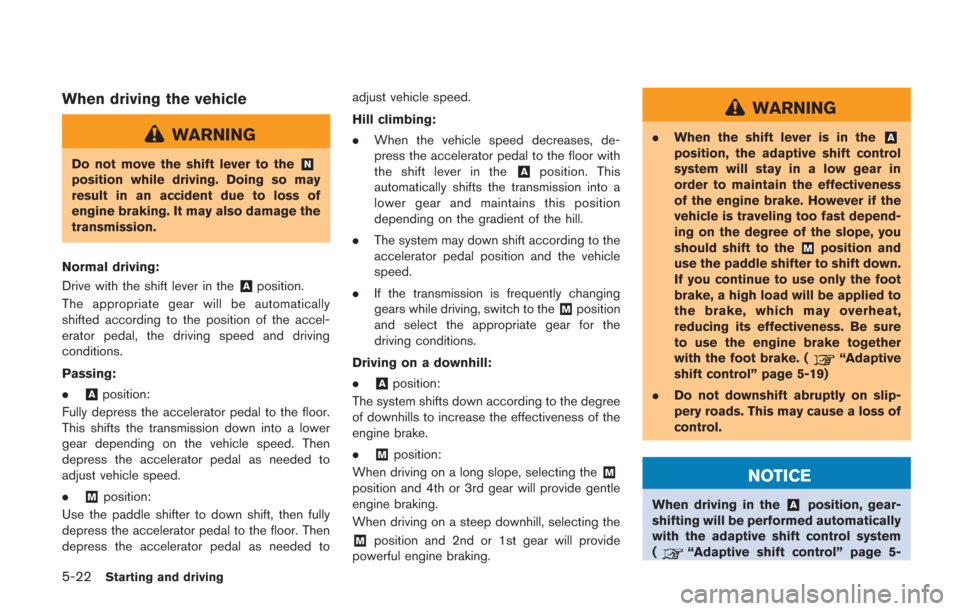
5-22Starting and driving
When driving the vehicle
WARNING
Do not move the shift lever to the&N
position while driving. Doing so may
result in an accident due to loss of
engine braking. It may also damage the
transmission.
Normal driving:
Drive with the shift lever in the
&Aposition.
The appropriate gear will be automatically
shifted according to the position of the accel-
erator pedal, the driving speed and driving
conditions.
Passing:
.
&Aposition:
Fully depress the accelerator pedal to the floor.
This shifts the transmission down into a lower
gear depending on the vehicle speed. Then
depress the accelerator pedal as needed to
adjust vehicle speed.
.
&Mposition:
Use the paddle shifter to down shift, then fully
depress the accelerator pedal to the floor. Then
depress the accelerator pedal as needed to adjust vehicle speed.
Hill climbing:
.
When the vehicle speed decreases, de-
press the accelerator pedal to the floor with
the shift lever in the
&Aposition. This
automatically shifts the transmission into a
lower gear and maintains this position
depending on the gradient of the hill.
. The system may down shift according to the
accelerator pedal position and the vehicle
speed.
. If the transmission is frequently changing
gears while driving, switch to the
&Mposition
and select the appropriate gear for the
driving conditions.
Driving on a downhill:
.
&Aposition:
The system shifts down according to the degree
of downhills to increase the effectiveness of the
engine brake.
.
&Mposition:
When driving on a long slope, selecting the
&M
position and 4th or 3rd gear will provide gentle
engine braking.
When driving on a steep downhill, selecting the
&Mposition and 2nd or 1st gear will provide
powerful engine braking.
WARNING
. When the shift lever is in the&A
position, the adaptive shift control
system will stay in a low gear in
order to maintain the effectiveness
of the engine brake. However if the
vehicle is traveling too fast depend-
ing on the degree of the slope, you
should shift to the
&Mposition and
use the paddle shifter to shift down.
If you continue to use only the foot
brake, a high load will be applied to
the brake, which may overheat,
reducing its effectiveness. Be sure
to use the engine brake together
with the foot brake. (
“Adaptive
shift control” page 5-19)
. Do not downshift abruptly on slip-
pery roads. This may cause a loss of
control.
NOTICE
When driving in the&Aposition, gear-
shifting will be performed automatically
with the adaptive shift control system
(
“Adaptive shift control” page 5-
Page 223 of 354
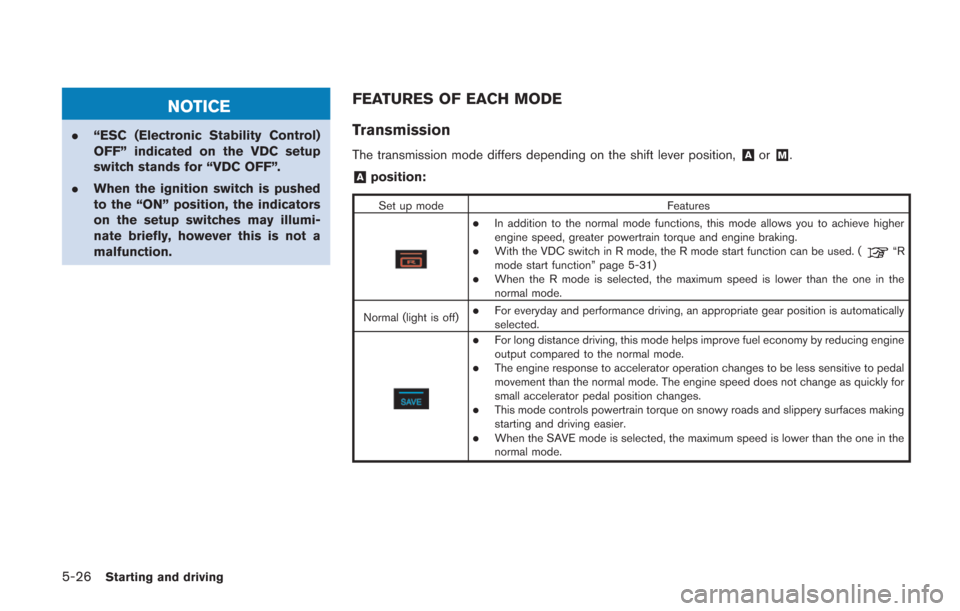
5-26Starting and driving
NOTICE
.“ESC (Electronic Stability Control)
OFF” indicated on the VDC setup
switch stands for “VDC OFF”.
. When the ignition switch is pushed
to the “ON” position, the indicators
on the setup switches may illumi-
nate briefly, however this is not a
malfunction.
FEATURES OF EACH MODE
Transmission
The transmission mode differs depending on the shift lever position,&Aor&M.
&Aposition:
Set up mode Features
.In addition to the normal mode functions, this mode allows you to achieve higher
engine speed, greater powertrain torque and engine braking.
.With the VDC switch in R mode, the R mode start function can be used. (“R
mode start function” page 5-31)
.When the R mode is selected, the maximum speed is lower than the one in the
normal mode.
Normal (light is off)
.For everyday and performance driving, an appropriate gear position is automatically
selected.
.For long distance driving, this mode helps improve fuel economy by reducing engine
output compared to the normal mode.
.The engine response to accelerator operation changes to be less sensitive to pedal
movement than the normal mode. The engine speed does not change as quickly for
small accelerator pedal position changes.
.This mode controls powertrain torque on snowy roads and slippery surfaces making
starting and driving easier.
.When the SAVE mode is selected, the maximum speed is lower than the one in the
normal mode.
Page 224 of 354
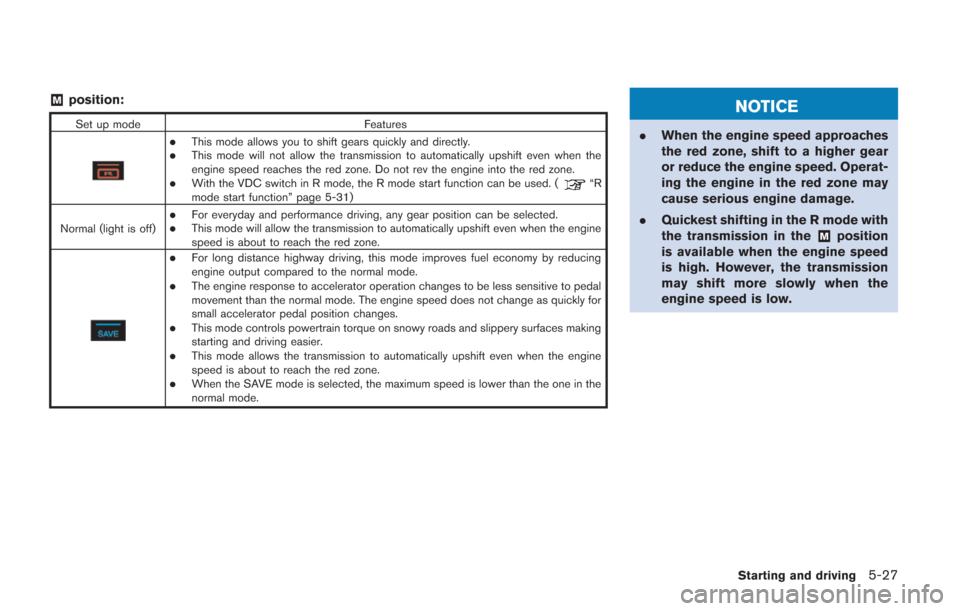
&Mposition:
Set up modeFeatures
.This mode allows you to shift gears quickly and directly..This mode will not allow the transmission to automatically upshift even when the
engine speed reaches the red zone. Do not rev the engine into the red zone.
.With the VDC switch in R mode, the R mode start function can be used. (“R
mode start function” page 5-31)
Normal (light is off)
.For everyday and performance driving, any gear position can be selected..This mode will allow the transmission to automatically upshift even when the engine
speed is about to reach the red zone.
.For long distance highway driving, this mode improves fuel economy by reducing
engine output compared to the normal mode.
.The engine response to accelerator operation changes to be less sensitive to pedal
movement than the normal mode. The engine speed does not change as quickly for
small accelerator pedal position changes.
.This mode controls powertrain torque on snowy roads and slippery surfaces making
starting and driving easier.
.This mode allows the transmission to automatically upshift even when the engine
speed is about to reach the red zone.
.When the SAVE mode is selected, the maximum speed is lower than the one in the
normal mode.
NOTICE
. When the engine speed approaches
the red zone, shift to a higher gear
or reduce the engine speed. Operat-
ing the engine in the red zone may
cause serious engine damage.
. Quickest shifting in the R mode with
the transmission in the
&Mposition
is available when the engine speed
is high. However, the transmission
may shift more slowly when the
engine speed is low.
Starting and driving5-27
Page 229 of 354
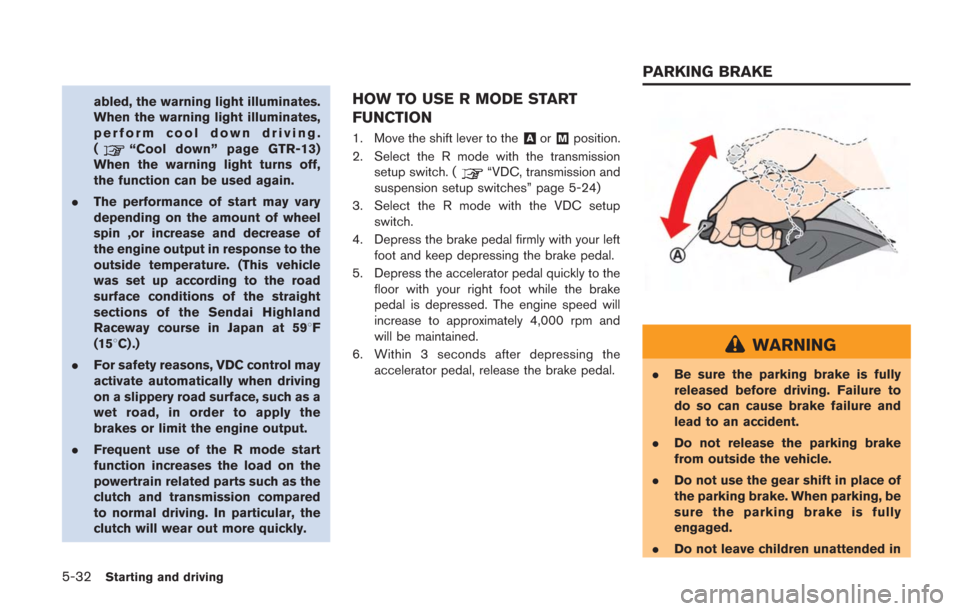
5-32Starting and driving
abled, the warning light illuminates.
When the warning light illuminates,
perform cool down driving.
(
“Cool down” page GTR-13)
When the warning light turns off,
the function can be used again.
. The performance of start may vary
depending on the amount of wheel
spin ,or increase and decrease of
the engine output in response to the
outside temperature. (This vehicle
was set up according to the road
surface conditions of the straight
sections of the Sendai Highland
Raceway course in Japan at 598F
(158C) .)
. For safety reasons, VDC control may
activate automatically when driving
on a slippery road surface, such as a
wet road, in order to apply the
brakes or limit the engine output.
. Frequent use of the R mode start
function increases the load on the
powertrain related parts such as the
clutch and transmission compared
to normal driving. In particular, the
clutch will wear out more quickly.
HOW TO USE R MODE START
FUNCTION
1. Move the shift lever to the&Aor&Mposition.
2. Select the R mode with the transmission setup switch. (
“VDC, transmission and
suspension setup switches” page 5-24)
3. Select the R mode with the VDC setup switch.
4. Depress the brake pedal firmly with your left foot and keep depressing the brake pedal.
5. Depress the accelerator pedal quickly to the floor with your right foot while the brake
pedal is depressed. The engine speed will
increase to approximately 4,000 rpm and
will be maintained.
6. Within 3 seconds after depressing the accelerator pedal, release the brake pedal.
WARNING
.Be sure the parking brake is fully
released before driving. Failure to
do so can cause brake failure and
lead to an accident.
. Do not release the parking brake
from outside the vehicle.
. Do not use the gear shift in place of
the parking brake. When parking, be
sure the parking brake is fully
engaged.
. Do not leave children unattended in
PARKING BRAKE
Page 234 of 354
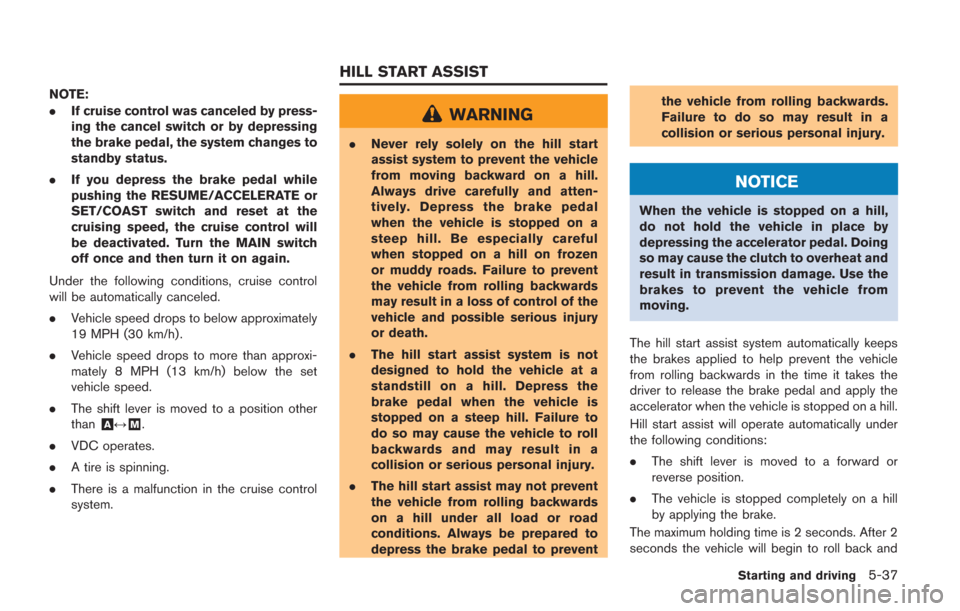
NOTE:
.If cruise control was canceled by press-
ing the cancel switch or by depressing
the brake pedal, the system changes to
standby status.
. If you depress the brake pedal while
pushing the RESUME/ACCELERATE or
SET/COAST switch and reset at the
cruising speed, the cruise control will
be deactivated. Turn the MAIN switch
off once and then turn it on again.
Under the following conditions, cruise control
will be automatically canceled.
. Vehicle speed drops to below approximately
19 MPH (30 km/h) .
. Vehicle speed drops to more than approxi-
mately 8 MPH (13 km/h) below the set
vehicle speed.
. The shift lever is moved to a position other
than
&A↔&M.
. VDC operates.
. A tire is spinning.
. There is a malfunction in the cruise control
system.
WARNING
.Never rely solely on the hill start
assist system to prevent the vehicle
from moving backward on a hill.
Always drive carefully and atten-
tively. Depress the brake pedal
when the vehicle is stopped on a
steep hill. Be especially careful
when stopped on a hill on frozen
or muddy roads. Failure to prevent
the vehicle from rolling backwards
may result in a loss of control of the
vehicle and possible serious injury
or death.
. The hill start assist system is not
designed to hold the vehicle at a
standstill on a hill. Depress the
brake pedal when the vehicle is
stopped on a steep hill. Failure to
do so may cause the vehicle to roll
backwards and may result in a
collision or serious personal injury.
. The hill start assist may not prevent
the vehicle from rolling backwards
on a hill under all load or road
conditions. Always be prepared to
depress the brake pedal to prevent the vehicle from rolling backwards.
Failure to do so may result in a
collision or serious personal injury.
NOTICE
When the vehicle is stopped on a hill,
do not hold the vehicle in place by
depressing the accelerator pedal. Doing
so may cause the clutch to overheat and
result in transmission damage. Use the
brakes to prevent the vehicle from
moving.
The hill start assist system automatically keeps
the brakes applied to help prevent the vehicle
from rolling backwards in the time it takes the
driver to release the brake pedal and apply the
accelerator when the vehicle is stopped on a hill.
Hill start assist will operate automatically under
the following conditions:
. The shift lever is moved to a forward or
reverse position.
. The vehicle is stopped completely on a hill
by applying the brake.
The maximum holding time is 2 seconds. After 2
seconds the vehicle will begin to roll back and
Starting and driving5-37
HILL START ASSIST
Page 240 of 354
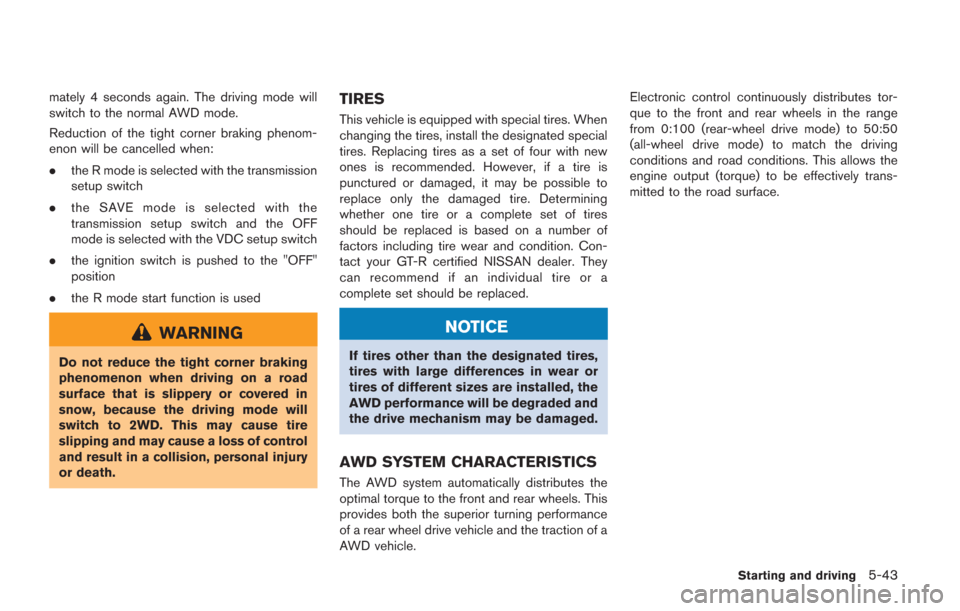
mately 4 seconds again. The driving mode will
switch to the normal AWD mode.
Reduction of the tight corner braking phenom-
enon will be cancelled when:
.the R mode is selected with the transmission
setup switch
. the SAVE mode is selected with the
transmission setup switch and the OFF
mode is selected with the VDC setup switch
. the ignition switch is pushed to the "OFF"
position
. the R mode start function is used
WARNING
Do not reduce the tight corner braking
phenomenon when driving on a road
surface that is slippery or covered in
snow, because the driving mode will
switch to 2WD. This may cause tire
slipping and may cause a loss of control
and result in a collision, personal injury
or death.
TIRES
This vehicle is equipped with special tires. When
changing the tires, install the designated special
tires. Replacing tires as a set of four with new
ones is recommended. However, if a tire is
punctured or damaged, it may be possible to
replace only the damaged tire. Determining
whether one tire or a complete set of tires
should be replaced is based on a number of
factors including tire wear and condition. Con-
tact your GT-R certified NISSAN dealer. They
can recommend if an individual tire or a
complete set should be replaced.
NOTICE
If tires other than the designated tires,
tires with large differences in wear or
tires of different sizes are installed, the
AWD performance will be degraded and
the drive mechanism may be damaged.
AWD SYSTEM CHARACTERISTICS
The AWD system automatically distributes the
optimal torque to the front and rear wheels. This
provides both the superior turning performance
of a rear wheel drive vehicle and the traction of a
AWD vehicle. Electronic control continuously distributes tor-
que to the front and rear wheels in the range
from 0:100 (rear-wheel drive mode) to 50:50
(all-wheel drive mode) to match the driving
conditions and road conditions. This allows the
engine output (torque) to be effectively trans-
mitted to the road surface.
Starting and driving5-43